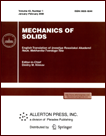 | | Mechanics of Solids
A Journal of Russian Academy of Sciences | | Founded
in January 1966
Issued 6 times a year
Print ISSN 0025-6544
Online ISSN 1934-7936 |
Archive of Issues
| Total articles in the database: | | 13362 |
| In Russian (Èçâ. ÐÀÍ. ÌÒÒ): | | 8178
|
| In English (Mech. Solids): | | 5184 |
|
| << Previous article | Volume 60, Issue 3 / 2025 | Next article >> |
| A.I. Andreev, A.E. Semenov, B.M. Slavin, and V.A. Chanchikov, "Dynamics of Precession of the Thompson Top," Mech. Solids. 60 (3), 1640-1649 (2025) |
| Year |
2025 |
Volume |
60 |
Number |
3 |
Pages |
1640-1649 |
| DOI |
10.1134/S0025654424606025 |
| Title |
Dynamics of Precession of the Thompson Top |
| Author(s) |
A.I. Andreev (Astrakhan State Technical University, Astrakhan, 414056 Russia, aresut79@mail.ru)
A.E. Semenov (Astrakhan State Technical University, Astrakhan, 414056 Russia)
B.M. Slavin (Astrakhan State Technical University, Astrakhan, 414056 Russia)
V.A. Chanchikov (Astrakhan State Technical University, Astrakhan, 414056 Russia) |
| Abstract |
In this article, the dynamics of precession of the Thompson top has been studied. Test
benches have been developed and experiments have been carried out. Based on the data obtained, the
dependences of the angular velocity of precession at high initial values of up to 340 rad/s are shown.
Analytical studies have been carried out and the dependences of energy changes during precession
have been obtained. The relation between the roughness coefficient and the resulting friction moment
is obtained. The relations between the work of friction and the roughness coefficient, that gives an
understanding of the dynamics of energy indicators during the entire process, are obtained. The question of the use of a viscous friction model remains open and as does a more detailed study of the proportionality coefficient to establish refined dependencies for precession. The experimental data
obtained show the influence of the roughness coefficient on precession and on the occurrence of the
friction force, leading to the capsizing of the top. Further research in this field should show the applicability of the viscous model and the study of critical points, namely the rise to the leg and the passage
of the highest value of the moment of inertia. |
| Keywords |
angular velocity, axial moment of inertia, Thompson top, precession of the Thompson top, kinetic momentum, friction losses, roughness coefficient, total precessional energy, potential energy, kinetic energy, practical application of the Thompson top |
| Received |
28 October 2024 | Revised |
28 December 2024 | Accepted |
28 December 2024 |
| Link to Fulltext |
|
| << Previous article | Volume 60, Issue 3 / 2025 | Next article >> |
|
 If you find a misprint on a webpage, please help us correct it promptly - just highlight and press Ctrl+Enter If you find a misprint on a webpage, please help us correct it promptly - just highlight and press Ctrl+Enter
|
|

 Russian
Russian  English
English